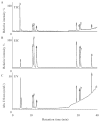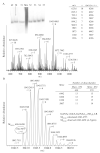Glycosaminoglycan characterization by electrospray ionization mass spectrometry including fourier transform mass spectrometry
- PMID: 20816475
- PMCID: PMC3234587
- DOI: 10.1016/S0076-6879(10)78003-4
Glycosaminoglycan characterization by electrospray ionization mass spectrometry including fourier transform mass spectrometry
Abstract
Electrospray ionization mass spectrometry (ESI MS) is a versatile analytical technique in glycomics of glycosaminoglycans (GAGs). Combined with enzymology, ESI MS is used for assessing changes in disaccharide composition of GAGs biosynthesized under different environmental or physiological conditions. ESI coupled with high-resolution mass analyzers such as a Fourier transform mass spectrometer (FTMS) permits accurate mass measurement of large oligosaccharides and intact GAGs as well as structural characterization of GAG oligosaccharides using information-rich fragmentation methods such as electron detachment dissociation. The first part of this chapter describes methods for disaccharide compositional profiling using ESI MS and the second part is dedicated to FTMS and tandem MS methods of GAG compositional and structural analysis.
Copyright (c) 2010 Elsevier Inc. All rights reserved.
Figures











Similar articles
-
Capillary Zone Electrophoresis-Electrospray Ionization Tandem Mass Spectrometry for Total Analysis of Chondroitin/Dermatan Sulfate Oligosaccharides.Methods Mol Biol. 2022;2531:163-184. doi: 10.1007/978-1-0716-2493-7_11. Methods Mol Biol. 2022. PMID: 35941485
-
Negative electron transfer dissociation Fourier transform mass spectrometry of glycosaminoglycan carbohydrates.Eur J Mass Spectrom (Chichester). 2011;17(2):167-76. doi: 10.1255/ejms.1120. Eur J Mass Spectrom (Chichester). 2011. PMID: 21719917 Free PMC article.
-
High-performance liquid chromatography-mass spectrometry for mapping and sequencing glycosaminoglycan-derived oligosaccharides.Nat Protoc. 2010 Jun;5(6):993-1004. doi: 10.1038/nprot.2010.48. Nat Protoc. 2010. PMID: 20448545 Free PMC article.
-
Methods in enzymology: O-glycosylation of proteins.Methods Enzymol. 2005;405:139-71. doi: 10.1016/S0076-6879(05)05007-X. Methods Enzymol. 2005. PMID: 16413314 Review.
-
Applications of capillary electrophoresis electrospray ionization mass spectrometry in glycosaminoglycan analysis.Electrophoresis. 2016 Apr;37(7-8):973-86. doi: 10.1002/elps.201500461. Epub 2016 Feb 1. Electrophoresis. 2016. PMID: 26701317 Review.
Cited by
-
Structural analysis of urinary glycosaminoglycans from healthy human subjects.Glycobiology. 2020 Feb 19;30(3):143-151. doi: 10.1093/glycob/cwz088. Glycobiology. 2020. PMID: 31616929 Free PMC article.
-
Glycomics hits the big time.Cell. 2010 Nov 24;143(5):672-6. doi: 10.1016/j.cell.2010.11.008. Cell. 2010. PMID: 21111227 Free PMC article.
-
Oligosaccharide analysis by mass spectrometry: a review of recent developments.Anal Chem. 2014 Jan 7;86(1):196-212. doi: 10.1021/ac403969n. Epub 2013 Dec 16. Anal Chem. 2014. PMID: 24313268 Free PMC article. Review. No abstract available.
-
Analysis of the Glycosaminoglycan Chains of Proteoglycans.J Histochem Cytochem. 2021 Feb;69(2):121-135. doi: 10.1369/0022155420937154. Epub 2020 Jul 6. J Histochem Cytochem. 2021. PMID: 32623943 Free PMC article. Review.
-
ELECTRON DETACHMENT DISSOCIATION OF SYNTHETIC HEPARAN SULFATE GLYCOSAMINOGLYCAN TETRASACCHARIDES VARYING IN DEGREE OF SULFATION AND HEXURONIC ACID STEREOCHEMISTRY.Int J Mass Spectrom. 2012 Dec 15;330-332:152-159. doi: 10.1016/j.ijms.2012.07.002. Int J Mass Spectrom. 2012. PMID: 23230388 Free PMC article.
References
-
- Bielik AM, Zaia J. Historical overview of glycoanalysis. Methods Mol. Biol. 2010;600:9–30. - PubMed
-
- Budnik BA, Haselmann KF, Zubarev RA. Electron detachment dissociation of peptide di-anions: An electron-hole recombination phenomenon. Chem. Phys. Lett. 2001;342:299–302.
-
- Capon C, Mizon C, Lemoine J, Rodie-Talbere P, Mizon J. In acute inflammation, the chondroitin-4 sulphate carried by bikunin is not only longer, it is also undersulphated. Biochimie. 2003;85:101–107. - PubMed
-
- Ceroni A, Maass K, Geyer H, Geyer R, Dell A, Haslam SM. Glyco-Workbench: A tool for the computer-assisted annotation of mass spectra of glycans. J. Proteome Res. 2008;7:1650–1659. - PubMed
Publication types
MeSH terms
Substances
Grants and funding
LinkOut - more resources
Full Text Sources

